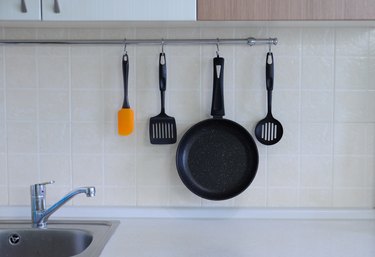
Nonstick pans are extremely popular and for good reason. They help home chefs to avoid the use of excessive oil in their cooking by ensuring food doesn't stick to the pan's surface. Many nonstick pan coatings are perfectly safe, but others have been deemed hazardous once they begin chipping away. Fortunately, there are ways to repair nonstick pans and perform DuPont pan resurfacing, though it is not always advised that you do so.
Important Safety Considerations
Video of the Day
Some pan coatings are made of Teflon; others are made of Xylan. There are countless other pan coatings, most given a branded name by their manufacturer. Before deciding how to proceed with a nonstick pan that is chipping, it's good to learn a bit more about the material it's made of.
Video of the Day
For instance, Coating Systems Inc. explains that Xylan can withstand temperatures up to 500 degrees Fahrenheit. Chances are that you wouldn't heat a pan to that temperature on your stove at home. However, once the temperature exceeds 500 degrees and approaches 600 degrees, Xylan can start to emit a toxic chemical.
Teflon has long been noted to have deleterious effects if you are exposed to it directly. The Milwaukee Journal Sentinel explains that not only is consuming the chipped nonstick coating potentially harmful, cooking chipped nonstick pans at very high temperatures can be toxic. The coating releases toxins that are more easily absorbed once it is no longer fully intact.
Using a Nonstick Repair Spray
To be completely safe, you should dispose of nonstick pans that are chipped to avoid potential ingestion of dangerous toxins. However, if you have your heart set on keeping your cookware, you can purchase a nonstick cookware repair spray at home improvement stores or online. Be sure to review the package instructions before you get started. In addition, only use these products in well-ventilated areas and store out of reach of children and pets.
First, be sure that your pan is clean and dry. Remove any loose bits of coating or food particles and pat dry with a microfiber cloth. Then, apply the repair spray as directed by the manufacturer. Usually, you will need to hold the pan about one foot away from the aerosol can and move the can slowly back and forth to ensure even coverage.
Allow the pan to dry for about 30 minutes. Once it has dried completely, you can place it in your oven, set at about 500 degrees Fahrenheit to allow the coating to set. Bake the pan for 45 minutes, then allow it to cool completely before you remove it from the oven. Wash the pan thoroughly in hot, soapy water before its next use.
Proper Nonstick Pan Maintenance
To correctly maintain your nonstick cookware, do not use metal or sharp-edged utensils when cooking with then. Ideally, you should select silicone or nylon spoons, spatulas and turners for your nonstick cookware. Note that silicone has a higher heat resistance than nylon, which can melt if left in direct contact with your cookware for a prolonged period at high temperatures.